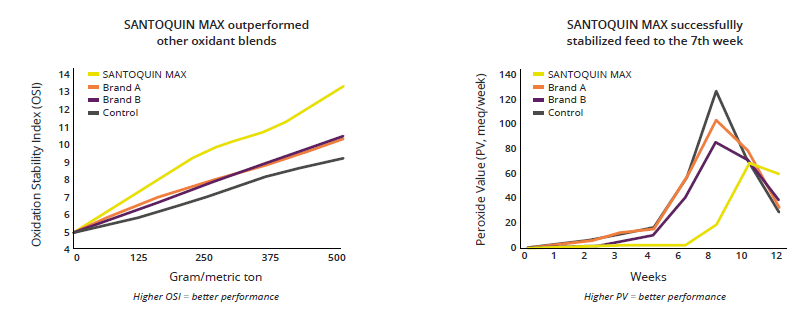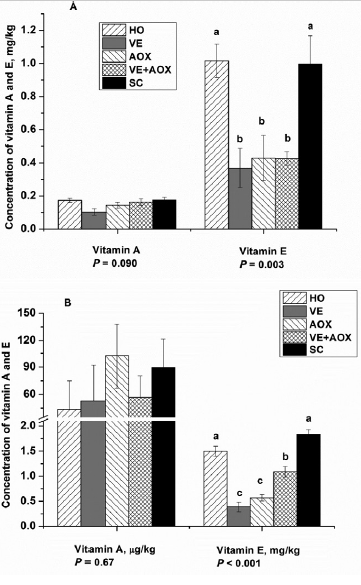By Technical Team, EW Nutrition
In modern swine production, one of the key aspects for success is a balanced diet. This essentially means ensuring that the animal meets its daily nutritional requirements for maintenance, growth, and reproduction. In order to provide an appropriate diet and safe feed for the animals, the sensory and nutritional characteristics of the feed must be preserved and issues like the oxidation of the feed must be avoided.

This article aims to highlight why oxidation in feed can become a big concern for swine producers, what the problems resulting from oxidation in pig feed are, and present practical solutions to improve feed quality and pig performance by controlling the oxidation.
Feed oxidation: What are the dangers?
In pig diets, various sources of lipids are added to increase caloric density, provide essential fatty acids, improve feed palatability, improve pellet quality, and reduce dust (Keer et al., 2015). Some of the feed ingredients are more susceptible to oxidation because of their physical and chemical characteristics, such as milled grains and ingredients of animal origin and vegetable oils with a high content of polyunsaturated fatty acids.
Oxidative rancidity is a type of lipid deterioration. In the oxidation process, the free radicals react with lipids and proteins and induce cellular and tissue damage.
Some consequences of oxidative deterioration are the destruction of fat-soluble vitamins, supplemental fats, and oils. Preserving these ingredients is crucial because fats and oils provide a high quantity of energy and essential fatty acids. At the same time, vitamins, such as those present in vitamin premixes, are indispensable for optimal animal growth and performance.
The oxidation process also results in by-products with strong unpleasant taste and odor, and even toxic metabolites. In addition, oxidized feed has less protein, amino acids, and energy content. All these factors are relevant when resources, in the current scenario of high prices of feed ingredients and inputs, might be wasted due to poor feed management.
Performance losses caused by oxidation
Lipid oxidation can incur several losses regarding the pigs’ performance. Feeding oxidized lipids significantly decreases growth rate, feed intake and efficiency, immune function, and weight gain efficiency in pigs, especially in breeding animals, since the exposure occurs over long periods.
The ingestion of products resulting from the oxidative deterioration of fatty acids leads to irritability of the intestinal mucosa, diarrhea, and, in extreme cases, can result in liver degeneration and cell death. DeRouchey et al. (2004) observed reduced growth rates in pigs that are fed rancid white grease. Ringseis et al. (2007) reported that feeding oxidized sunflower oil increased oxidative stress markers in the small intestine of pigs, while Boler et al. (2012) reported that feeding pigs oxidized corn oil reduced growth performance (Table 1). Lu et al. (2014a) reported signs of liver damage in pigs subjected to dietary oxidative stress, increasing plasma bilirubin content, and enlarged liver size.

Table 1. Effects of dietary corn oil quality and antioxidant inclusion on barrow performance (Source: Boler et al., 2012)
There are some theories as to why oxidized feed causes such effects. According to Dibner et al. (1996), vitamins and polyunsaturated fatty acids deteriorate in the absence of antioxidants, and oxidized fats and their byproducts can negatively affect cells, resulting in changes in membrane permeability, viscosity, secretory activity, and membrane-bound enzyme activity. These primary effects lead to observable systemic effects. In order to prevent these damaging consequences, antioxidants have become a widely used alternative.
The power of antioxidants
Chemical antioxidants (Table 2) are added to animal feeds to delay fat and vitamin oxidation, which keeps the diet palatable and helps prolong the feed’s shelf life, ultimately maintaining the quality of the ingredients (Jacela et al., 2010). They prevent the binding of oxygen to free radicals. Dietary antioxidants have also been used in several species of animals to replace vitamin E, which is known for its antioxidant powers. Antioxidants are highly applicable in warm climates, when high levels of fat are added to the diet, and in areas where byproducts high in unsaturated fats are commonly used.

Table 2. Commonly used chemical antioxidants
Lu et al. (2014b) studied the effects of dietary supplementation with a blend of antioxidants (ethoxyquin and propyl gallate) on carcass characteristics, meat quality, and fatty acid profile in finishing pigs fed a diet high in oxidants. They reported that the inclusion of antioxidants minimized the effects of the high oxidant diet. The treatments including antioxidants, whether combined with vitamin E or not, had positive results in carcass weight, back fat, loin characteristics, and extractable lipid percentage.
Fernandez-Duenas (2009) studied the use of antioxidants in feed containing fresh or oxidized corn oil and its effects on animal performance, the oxidative status of tissues, meat quality, shelf life, and the antioxidant activity of skeletal muscle of finishing pigs. They reported that barrows fed with diets with the antioxidant blend showed increased feed efficiency. Orengo et al. (2021) showed that feeds protected with antioxidants could compensate for low vitamin E supply with regard to growth performance in the starter phase. Hung et al., 2017 theorized that the impacts on growth performance are likely related to the lack of adequate antioxidant capacity of the diet and oxidative stress status.
As literature and application results show, the use of antioxidants in pig feed is crucial to minimize adverse effects from oxidized feed and allow the animals to express their full performance potential.
SANTOQUIN: preserving feed quality
From a practical standpoint, swine producers must consider some criteria for selecting a good antioxidant, which must preserve feed components, be nontoxic for humans and pigs, show effectiveness at very low concentrations, and be economically sustainable.
Considering those major characteristics, EW Nutrition offers a range of antioxidant solutions for the preservation of feed ingredients and feeds for poultry and swine through their SANTOQUIN product line. Santoquin is a feed preservative that protects supplemental fats, oils, meals, and vitamin premixes and protect feed from oxidation. Santoquin provides unsurpassed protection from oxidative rancidity, and it has proven effects against oxidation in feeds (Figure 1) ensuring the prolonged shelf life of feeds, especially during suboptimal storage conditions, such as those with high environmental temperature and elevated levels of moisture.

Figure 1. Antioxidant efficacy and competitiveness. SANTOQUIN MAX feed preservative is a proprietary antioxidant blend that effectively prolongs the shelf life of feed and feed ingredients by reducing oxidation rate.
Studies have been conducted to show the beneficial effects of Santoquin. Ethoxyquin, contained in Santoquin, has been used in the swine industry for over five decades and has been shown to improve growth performance and markers of oxidative status in pigs (Dibner et al., 1996). Ethoxyquin is also known for being the most efficacious and cost-effective antioxidant. Lu et al. (2014b) showed that the addition of an antioxidant blend (ethoxyquin and propyl gallate) protected pigs fed with a high-oxidant diet from oxidative stress more efficiently than vitamin E supplementation (Figure 2).

Figure 2. Concentrations of vitamins A and E across treatments in the plasma (A) and muscle (B). HO: high oxidant diet containing 5% oxidized soybean oil (peroxide value at approximately 180 mEq/kg of oil, 9 mEq/kg in the diet) and 10% of a PUFA source (providing approximately 55.57% of crude fat that contains docosahexaenoic acid [ DHA] at 36.75%, and 2.05% DHA in the diet); VE: the HO diet with 11 IU/kg of added vitamin E; AOX: the HO diet with an antioxidant blend (ethoxyquin and propyl gallate, 135 mg/kg); VE+AOX: the HO diet with both vitamin E and antioxidant blend; SC: a standard corn–soy control diet with nonoxidized oil and no PUFA source. The HO pigs were switched to the SC diet after day 82 as an intervention for poor health and performance. The samples came from two pigs from each pen. The VE treatment lost 1 replicate during the feeding phase and transportation period (n = 4), while in other treatments, n =5. (Source: Lu et al., 2014b)
Conclusion
The negative effects of oxidation in pig feed can result in diets with lower biological energy value. To avoid that, antioxidants help maintain intestinal health, ensure a safe food intake, preserve the ingredients and resources used in pig production. Overall, antioxidants help swine producers improve feed conversion and achieve more productive animals and lower mortality caused by toxicity. At the end of the day, the use of antioxidants is associated with better profitability.
References
Boler, D. D., Fernández-Dueñas, D. M., Kutzler, L. W., Zhao, J., Harrell, R. J., Campion, D. R., Mckeith, F. K., Killefer, J., & Dilger, A. C. (2012). Effects of oxidized corn oil and a synthetic antioxidant blend on performance, oxidative status of tissues, and fresh meat quality in finishing barrows. Journal of Animal Science, 90(13), 5159–5169. https://doi.org/10.2527/jas.2012-5266
DeRouchey, J. M., Hancock, J. D., Hines, R. H., Maloney, C. A., Lee, D. J., Cao, H., Dean, D. W., & Park, J. S. (2004). Effects of rancidity and free fatty acids in choice white grease on growth performance and nutrient digestibility in weanling pigs. Journal of Animal Science, 82(10), 2937–2944. https://doi.org/10.2527/2004.82102937x
Dibner, J. J., Atwell, C. A., Kitchell, M. L., Shermer, W. D., & Ivey, F. J. (1996). Feeding of oxidized fats to broilers and swine: Effects on enterocyte turnover, hepatocyte proliferation and the gut associated lymphoid tissue. Animal Feed Science and Technology, 62(1 SPEC. ISS.), 1–13. https://doi.org/10.1016/S0377-8401(96)01000-0
Fernández-dueñas, D. M. (2009). Impact of oxidized corn oil and synthetic antioxidant on swine performance, antioxidant status of tissues, pork quality, and shelf life evaluation.
Hung, Y. T., Hanson, A. R., Shurson, G. C., & Urriola, P. E. (2017). Peroxidized lipids reduce growth performance of poultry and swine: A meta-analysis. Animal Feed Science and Technology, 231, 47–58. https://doi.org/10.1016/j.anifeedsci.2017.06.013
Jacela, J. Y., DeRouchey, J. M., Tokach, M. D., Goodband, R. D., Nelssen, J. L., Renter, D. G., & Dritz, S. S. (2010). Feed additives for swine: Fact sheets–flavors and mold inhibitors, mycotoxin binders, and antioxidants. Journal of Swine Health and Production, 18(1), 27-32.
Kerr, B. J., Kellner, T. A., & Shurson, G. C. (2015). Characteristics of lipids and their feeding value in swine diets. Journal of Animal Science and Biotechnology, 6(1), 1-23. https://doi.org/10.1186/s40104-015-0028-x
Lu, T., Harper, A. F., Zhao, J., Estienne, M. J., & Dalloul, R. A. (2014). Supplementing antioxidants to pigs fed diets high in oxidants: I. Effects on growth performance, liver function, and oxidative status. Journal of animal science, 92(12), 5455-5463. https://doi.org/10.2527/jas.2013-7109
Lu, T., Harper, A. F., Dibner, J. J., Scheffler, J. M., Corl, B. A., Estienne, M. J., Zhao, J., & Dalloul, R. A. (2014b). Supplementing antioxidants to pigs fed diets high in oxidants: II. Effects on carcass characteristics, meat quality, and fatty acid profile. Journal of Animal Science, 92(12), 5464–5475. https://doi.org/10.2527/jas.2013-7112
Orengo, J., Hernández, F., Martínez-Miró, S., Sánchez, C. J., Peres Rubio, C., & Madrid, J. (2021). Effects of commercial antioxidants in feed on growth performance and oxidative stress status of weaned piglets. Animals, 11(2), 1–13. https://doi.org/10.3390/ani11020266
Ringseis, R., Piwek, N., & Eder, K. (2007). Oxidized fat induces oxidative stress but has no effect on NF-κB-mediated proinflammatory gene transcription in porcine intestinal epithelial cells. Inflammation Research, 56(3), 118–125. https://doi.org/10.1007/s00011-006-6122-y
















